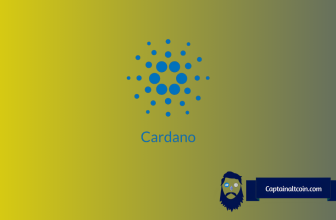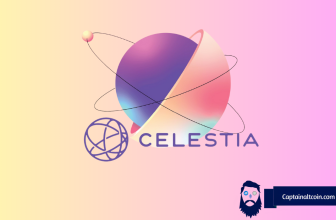
Privacy is an issue often talked about in the world of crypto. Most of the currently existing platforms utilize open, public ledgers which offer little in the way of protecting the amounts you send and who you send them to. Realizing that some crypto users have a need to retain the privacy of their information (with certain investors willing to pay a premium for Bitcoin with no previous transaction history), several cryptocurrency projects set wheels in motion to find a way of satisfying these needs. One of such cryptocurrencies is called Grin.
Grin is a blockchain/cryptocurrency focused on privacy and scalability that wants to change the way we use digital money. Founded and developed by a community effort, this project is based on the revolutionary MimbleWimble protocol. To understand what exactly this cryptocurrency wants to do, we need to take a closer look at the underlying technology first.
What you'll learn 👉
What is MimbleWimble protocol?
MimbleWimble was initially mentioned and described by a Bitcoin search channel user Tom Elvis Jedusor, which is the French name of Voldemort, a character from the popular book/movie series Harry Potter. The name of the protocol is also taken from the same fantasy world and represents a spell which “binds the target’s tongue to keep him or her from talking about a specific subject”. This explains why this privacy focused project bears the name “MimbleWimble”. To conclude the Harry Potter/privacy analogies, a user named Ignotus Peverell (original owner of the invisibility cloak item in the books) took the original MimbleWimble whitepaper and started the Grin project on the software development platform Github back in 2016.
MimbleWimble is a blockchain protocol that mixes several innovative technologies to radically change how transactions are constructed in Bitcoin and reduce the size of the blockchain. The project focuses on providing better privacy/scalability than Bitcoin by removing the need for addresses and minimizing the data storage requirements. With the mentioned two features included in MimbleWimble (and subsequently into Grin), all that is left for this new piece of technology is ensure decentralization and price stability. MimbleWimble developers think that they will be able to do that.
The MimbleWimble protocol offers non-transparent, private transactions; it relies on Elliptic Curve Cryptography (ECC) to build opaque transactions that are still verifiable. It combines two cryptographic features designed for Bitcoin:
- Confidential Transactions (CT)
Developed by Bitcoin developer, Gregory Maxwell, and also deployed on Blockstream’s Liquid sidechain, CT’s let users hide the amounts of a transaction so that only the sender/receiver know how much was actually sent. This technology allows senders to encrypt the number of Bitcoins they want to send using what we call blinding factors, elements that are made by combining the transacting parties’ private and public keys.
?This is our comparison of ethereum vs bitcoin.
In MimbleWimble there are no addresses. Blinding factors are used to connect two members of a transaction. The blinding factor is shared between the two parties that are transacting and no outsider has access to it. Later on, this blinding factor can be leveraged to prove ownership of the values that were sent. The factor is ultimately used to encrypt the inputs/outputs of the transaction as well as the public/private keys of the transactors. Using a piece of technology called the Pedersen Commitment (where full nodes subtract the encrypted amounts on the sending side of transactions from the encrypted amounts on the receiving side of transactions), network verifiers can confirm that the transactions are real and no cryptocurrency was created out of thin air.
- CoinJoin
Also developed by Maxwell, this technology lets us combine several transactions into a single big transaction where all senders send money to all receivers. Thanks to that we can obfuscate which receivers get which coins, in a manner similar to what you see with the RingCT technology (a feature used in popular privacy coins Monero and Zcash).
It is clear that a level of privacy never before seen with Bitcoin can be achieved with MimbleWimble. Your transaction is sent “in bulk” with other transactions and its value is a mystery to the network or any outside observer; as no addresses are used, no one can connect your name to a single address and later track your transaction activity. There is much more to say about the MimbleWimble technology and we couldn’t fit all of the information in a single, introductory article; if you want to know more, check out the official introduction into the protocol given by the Grin Github.
What is Grin?
Grin is a cryptocurrency utilizing the MimbleWimble as the protocol behind its blockchain. It is designed to provide privacy, scalability and fungibility to the end user with a system that doesn’t have any addresses or transaction amounts. Because of that, a Grin block contains no transactions; the block itself looks like one big transaction. Also, all the original associations between input and output are lost and mixed with others. Due to all of this, the currency’s blockchain is extremely lightweight and doesn’t require much hard disk space to be stored.
The currency is often touted as the Rust implementation of MimbleWimble. Developed using the mentioned programming language, the project utilizes another industry first in the Cuckoo Cycle PoW mining algorithm. This algorithm is apparently ASIC resistant thanks to being memory intensive; as such, it is possible to mine the cryptocurrency using your computer’s CPU. This means that mining Grin will be a cheap endeavor; all of this should encourage decentralization of the mining network. Once Grin launches, a single new coin will be mined each second on average and this rate will not change over time.
?Read our head to head comparison of crypto exchanges: Binance vs Kucoin
The project was entirely community funded, to the tune of $55,000. The currency is community developed as well, with ad-hoc part time developers bearing the most of the responsibility. There is no one claiming ownership of the project and no pre-mines or ICO’s will be launched.
Regarding Grin’s monetary policy, it will be an intriguing one. The currency will employ inflation as a percentage of existing supply; this inflation will be high early on but gradually lowers over time, approaching zero percent but never actually reaching that. This inflation will be less than 10% during the first 10 years, then less than 5% after 20 years, and will continually drop across time. This signals that Grin isn’t looking to emulate Bitcoin as a limited supply currency. Grin community feels that mining networks of Bitcoin and similar limited supply currencies might react in unpredictable ways once the last coin of each respective network is mined out and therefore feel that inflation is necessary to motivate the miners infinitely.
Grin’s high early inflation means that the currency’s stock-to-flow ratio is extremely low out of the gate. This encourages Grin holders to not HODL but instead spend their cryptocurrency, building up the ecosystem at a critical time of the currency’s existence. The currency will initially look to avoid being a store of value and will attempt to become the means of exchange first.
Weaknesses of Grin (and MimbleWimble in general) include the lack of scripts, meaning that Grin’s blockchain isn’t programmable. Another important one is that two wallets need to interact directly to create a transaction (meaning that they need to be online at the same time). It is also possible to create a spy node that receives and forwards most (if not all) individual transactions. This node could potentially record individual transactions and track which inputs are paying which outputs.
MimbleWimble and Grin claim that it is possible to solve all of these. Combining transactions before they hit the verification network, adding dummy outputs that contain zero coins, and implementing a technology called the Dandelion protocol are all suggested as possible solutions to the mentioned issues. Technologies like Schnorr signatures and Bulletproofs will also be compatible with Grin.
Conclusion
Grin is currently running the v4 version of its testnet and is expected to move onto the mainnet in early 2019.
EDIT: Grin has just launched on January 16th. The launch was successful and hashrate was solid right out of the gates.
Interesting technology solutions and a rarely seen monetary policy set this concept apart from other products on the market. Anonymous founder, leaderless development group, PoW consensus, no on-chain governance or pre-mine are just some of the features we mentioned above. Many experts agree that Grin and MimbleWimble have potential to develop privacy solutions that can eventually be used to improve other cryptocurrencies like Bitcoin. We’ll know more if any of that potential can be fulfilled in 2019.







Presenting Grin as THE Mimblewimble Project is a fake news or a paid content?
Nowhere did the article imply that Grin is THE MimbleWimble project. As Torsten said, the article is an overview of MimbleWimble technology given through the lens of Grin, one of the most popular MimbleWimble implementations currently out there.
Neither – it is an interesting concept and project people are searching for so we want to cover it. And your question is pretty dumb btw – how can this possible be a fake news? You have been watching too much Trump, tone it down, it is not good for your health.
Good writeup! Worth also mentioning Beam (www.beam.mw) – the other Mimblewimble implementation.
Thank you, we’ll try to check that one out in the future as well.